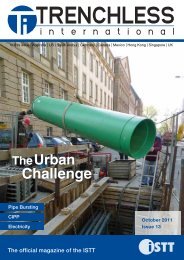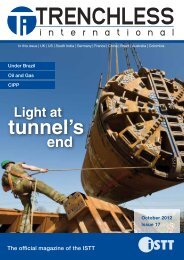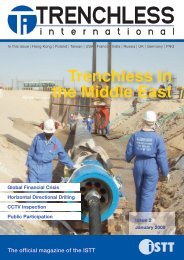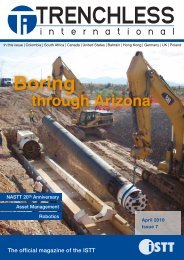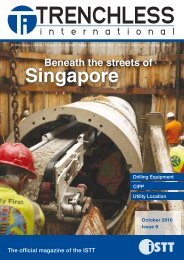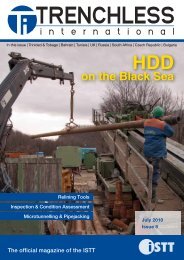North American Special - Trenchless International
North American Special - Trenchless International
North American Special - Trenchless International
You also want an ePaper? Increase the reach of your titles
YUMPU automatically turns print PDFs into web optimized ePapers that Google loves.
projects<br />
April 2009 - <strong>Trenchless</strong> <strong>International</strong><br />
Rehabilitation of a return<br />
line for cooling water<br />
An innovative low pressure pipeline repair technique has been tested at a power plant in Berlin.<br />
Michael Roeling describes the procedure and successful outcome of the test.<br />
With a capacity of 600 MW, Reuter<br />
West is the most powerful heat and power<br />
plant in Berlin, Germany. It consists of<br />
two equal units, each with an output of<br />
300 MW (block D and E), which were put<br />
into operation in 1987 and 1989 respectively<br />
and located next to the existing old<br />
power plant, Reuter.<br />
During recent routine maintenance<br />
checks it was noticed that two of the four<br />
return pipes connecting the side coolers<br />
with the main cooling return line between<br />
the cooling tower and unit E were showing<br />
leakages caused by pitting corrosion. The<br />
leaking pipes are made of welded steel,<br />
with a nominal diameter of 600 mm and are<br />
operated with a maximum pressure of 29<br />
psi. The pipeline had been partly assembled<br />
by welding half pipes together on site,<br />
causing tolerances in diameter, an unusual<br />
trait for steel pipelines.<br />
The return lines, together with many other<br />
lines, are installed in a service duct below a<br />
pavement designed for heavy-duty trucks.<br />
The replacement of larger pipe sections<br />
would have required the opening of the<br />
pavement, digging a trench and removing<br />
the reinforced concrete floor. This method<br />
was rejected from the beginning; primarily<br />
due to the obstruction it would cause to<br />
internal plant traffic, but also for cost reasons.<br />
The replacement of small sections<br />
inside the closed service duct by hand was<br />
also discussed as a possible alternative.<br />
However, the cost would have been quite<br />
high. In either case, the replacement could<br />
never have been executed within the time<br />
frame.<br />
BKP Berolina Polyester GmbH & Co<br />
offered to install the new Berolina-LP-Liner,<br />
the first field test of the product. This<br />
renovation solution promised cost advantages<br />
for the power plant’s owner Vattenfall<br />
Europe. Plant management decided to<br />
renovate a test section using the liner and<br />
await a result before making a final decision<br />
about the method of renovation or<br />
replacement.<br />
Preparation<br />
As the condition of the leaking pipes —<br />
except the pitting holes — was generally<br />
still good, the final decision on method was<br />
postponed for several months. The leakages<br />
were closed by welding steel plates<br />
over the holes. A 40 metre test section was<br />
left for the liner renovation test. This section<br />
was limited by a 90 degree bend with a<br />
wall duct that followed on one side. On the<br />
other side of the section, and an additional<br />
90 degree bend led into an extension section.<br />
The distance between the upper pipe,<br />
which had to be renovated, and the ceiling<br />
measured only 3 to 5 cm. First the bends<br />
were removed because the liner installation,<br />
and subsequent curing by using<br />
UV-light, required reasonably straight sections.<br />
Afterwards the section was scheduled<br />
to be cleaned by high pressure jetting.<br />
Unfortunately this was not sufficient as the<br />
pipe was encrusted with a hardened buildup<br />
that could have damaged the liner.<br />
An intensive cleaning and levelling of the<br />
pipe’s inner surface was carried out using<br />
a special scraper known as a ‘go-devil’<br />
(pictured).<br />
The insertion of the light train.<br />
Installation of the liner<br />
The liners were fibre reinforced plastics<br />
(FRP), using several layers of glass-fibre<br />
mesh reinforcement together with polyester<br />
resin which is cured by using UVA-light.<br />
So far the Berolina-Liners have been used<br />
for renovation of storm water or sewer<br />
pipes. The water tightness test in those<br />
cases followed the procedures of EN 1610<br />
with a maximum test pressure of 7.25 psi<br />
when using water and 1.45-2.90 psi when<br />
using air as a pressure medium. Based on<br />
the existing liner products the company<br />
ventured into a new product line to enable<br />
the renovation of pressure pipes.<br />
In this project, the liner for low pressure<br />
pipes was chosen to complete the test.<br />
Following the pipe cleaning, a polyethylene<br />
gliding foil was pulled in the pipe to<br />
protect the liner from damage by welding<br />
burrs or any remaining hardened build-up<br />
when being pulled in.<br />
Then the liner was pulled into the pipe<br />
with a hydraulic winch and closed with<br />
end caps.<br />
The liner was then inflated by air pressure<br />
in order to insert the UVA-light source.<br />
The light source consisted of a light train<br />
with eight metal halide lamps. The light<br />
spectrum was synchronised to the photo<br />
catalysts in the polyester resin. A curing<br />
unit, type Compact and made by HC<br />
PipeTech, was used for curing the liner.<br />
Due to the very small external dimensions<br />
of this equipment, the installation crew<br />
was able to bring the unit into the service<br />
duct by hand and through a door only 90<br />
cm wide.<br />
After the insertion of the light train, the<br />
liner was expanded close fit to the inner<br />
wall of the host pipe. The special design<br />
of the liner allows it to dialate over a<br />
relatively wide range of diameters – from<br />
5 per cent under measurement up to 5<br />
per cent over measurement compared<br />
with the specified size of the host pipe.<br />
Therefore, the large tolerances in diameter<br />
of the host pipe were not an issue for<br />
the liner.<br />
After dilatation, the light source was<br />
ignited and pulled through the liner at a<br />
defined speed. The UVA-light enabled the<br />
polymerisation of the polyester resin.<br />
After the curing had been completed<br />
the liner ends were cut with precision and<br />
the installed liner could be examined. The<br />
smoothness of the inner liner surface was<br />
striking. In a public sewer system the job<br />
would have been completed by this stage.<br />
In this case, the connection to the existing<br />
pipeline had to be made. Flange collars,<br />
also made of FRP, were bonded to the<br />
protruding liner ends and the continuing<br />
pipeline components with flange joints<br />
attached. This design was necessary for<br />
two reasons. Firstly, the design allowed for<br />
the opening of the test section for future<br />
inspections without destroying any part of<br />
the pipeline. Secondly, a joint by laminating<br />
was not possible because of the very<br />
narrow distance between the pipeline<br />
and the reinforced concrete ceiling. Even<br />
for the flange type of connection used in<br />
this project, the concrete cover had to<br />
be removed at some locations to allow<br />
enough working space.<br />
Summary<br />
The project described above has been<br />
accomplished in an extremely short time<br />
frame, especially considering the very<br />
tight working space. The renovation of the<br />
straight section, including cleaning with<br />
the ‘go-devil’, pulling in of gliding foil and<br />
liner, curing and exact cutting was done<br />
in a single day. The replacement of the<br />
pipe section with half pipes would have<br />
taken three to four weeks. The time taken<br />
for connecting the liner with the rest of<br />
the pipeline, as well as for the preparing<br />
works for removing the old steel bends,<br />
was within the normal time frame for this<br />
kind work. The pipe section renovated by<br />
ID 150 mm (~ 6‘‘) up to<br />
ID 1000 mm (~ 40‘‘)<br />
Glass fibre and/or polyester<br />
webs impregnated with resin<br />
Brief installation time<br />
Bridging of profile<br />
differences and cross<br />
sections<br />
Chemical resistant<br />
Suitable for all profiles<br />
Seamless construction<br />
Smooth surface<br />
Ready for installation<br />
Berolina-Liner System<br />
®<br />
Lightspeed sewer rehabilitation in 5 continents<br />
CIPP with UV-light<br />
The renovated pipe section.<br />
using the Berolina-LP Liner has been in<br />
full and unrestricted operation for over six<br />
months at the time of writing. From testing<br />
so far the Berolina-LP-Liner can be<br />
rated as reliable for this kind of pipeline<br />
renovation in power plants and other low<br />
pressure pipes.<br />
BKP Berolina Polyester GmbH & Co. KG, Berlin, Germany. For more information visit www.bkp-berolina.de or<br />
contact +49-30-36471-400 email info@bkp-berolina.de<br />
BKP Berolina Polyester GmbH & Co. KG<br />
Am Zeppelinpark 22<br />
13591 Berlin, Germany<br />
®<br />
UV-light source<br />
Tel.: +49 (0) 30 / 36471-400<br />
Fax: +49 (0) 30 / 36471-410<br />
info@bkp-berolina.de<br />
UVA-light in action.<br />
Insertion of the Berolina-LP-Liner.<br />
Less space required<br />
projects<br />
April 2009 - <strong>Trenchless</strong> <strong>International</strong><br />
30<br />
31






